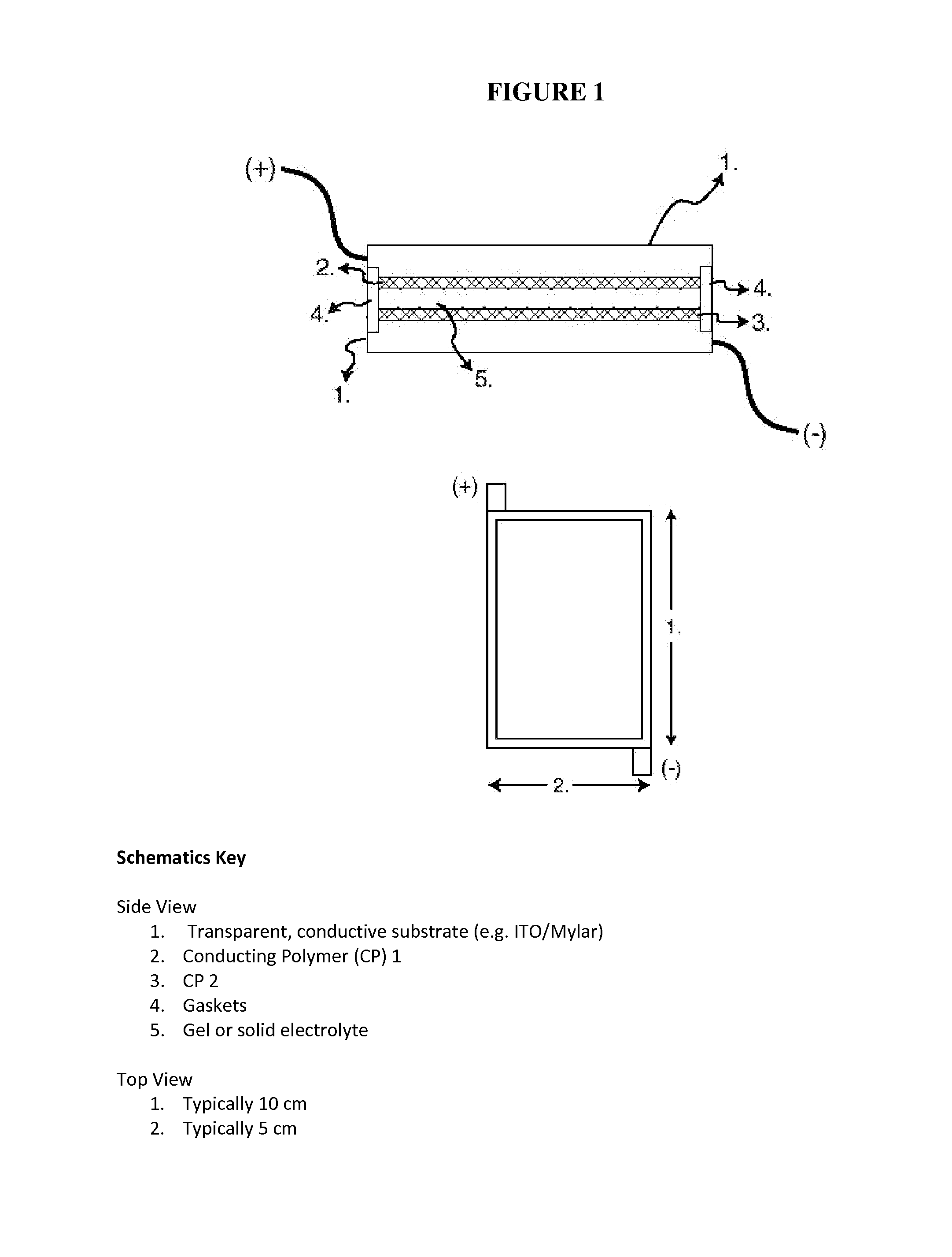Complimentary polymer electrochromic device
a technology of electrochromic devices and polymers, applied in the direction of electrochemical organic material coating, cell components, instruments, etc., can solve the problems of slow electrochromic switching time, poor reversibility of the electrochemical process in the electrochromic device, and a much more rapid degradation of the active electrochromic material
- Summary
- Abstract
- Description
- Claims
- Application Information
AI Technical Summary
Benefits of technology
Problems solved by technology
Method used
Image
Examples
example 1
Typical Synthesis of Monomer, 2,2-(bis-4-chlorobenzyl)-3,4-propylenedioxythiophene (“3,3-Bis(4-chlorobenzyl)-3,4-dihydro-2H-thieno[3,4-1)][1,4]-dioxepine”) (“Cl-Bz-PropOT”)
a. Synthesis of Initial Intermediate, diethyl bis(4-chloro-benzyl) malonate (Scheme, FIG. 4)
[0116]The synthesis was carried out under inert atmosphere with dry Argon gas utilizing a balloon apparatus. To a 250 mL round bottom flask was added 11.2 g (0.0545 mol) of 4-chlorobenzyl bromide, 17.0 g (0.123 mol) of potassium carbonate and 100 mL of anhydrous DMF. The neck of the flask was closed with a rubber septum and the flask was purged with Ar. A rubber balloon / needle apparatus was filled with Ar and inserted into the septum. After the balloon was attached, 3.3 mL (0.022 mol) of diethyl malonate was inserted via a syringe and the flask was heated to 100° C. for 16 h. The flask was cooled to room temperature and the reaction mixture was poured into 200 mL of water. The product was extracted with diethyl ether. The e...
example 5
Typical Synthesis of Monomer, 2,2-(bis-4-bromobenzyl)-3,4-propylenedioxythiophene (“3,3-Bis(4-bromobenzyl)-3,4-dihydro-2H-thieno[3,4-b][1,4]-dioxepine”) (“Br-Bz-PropOT”)
a. Synthesis of Initial Intermediate, diethyl bis(4-bromo-benzyl) malonate (Scheme, FIG. 5)
[0124]To a 250 mL round bottom flask was added 8.63 g (0.0345 mol) of 4-bromobenzyl bromide, 17.0 g (0.123 mol) of potassium carbonate and 100 mL of anhydrous DMF. The neck of the flask was closed with a rubber septum and the flask was purged with Ar. A rubber balloon / needle apparatus was filled with Ar and inserted into the septum. After the balloon was attached, 2.2 mL (0.014 mol) of diethyl malonate was inserted via a syringe and the flask was heated to 100° C. for 16 h. The flask was cooled to room temperature and the reaction mixture was poured into 200 mL of water. The product was extracted with diethyl ether. The ether layer was washed three times with 100 mL of half brine and once with 100 mL of brine. The ether layer w...
example 6
Typical Synthesis of Monomer, 2,2-(bis-4-nitrobenzyl)-3,4-propylenedioxythiophene (“3,3-Bis(4-nitrobenzyl)-3,4-dihydro-2H-thieno[3,4-b][1,4]-dioxepine”) (“Nitro-Bz-PropOT”)
a. Synthesis of the Intermediate 2,2-Dimethyl-5,5-di(4-nitrobenzyl)-1,3-dioxane-4,6-dione (See Scheme, FIG. 6)
[0128]An adaptation of the procedure of Fillion et al. (2005) was followed. To a 1 L round bottom flask was added 11.23 g (0.0520 mol) of 4-nitrobenzyl bromide, 3.0 g (0.0208 mol) of 2,2-dimethyl-1,3-dioxane-4,6-dione (Meldrum's acid), 9.5 g (0.0687 mol) of potassium carbonate and 150 mL of DMF. This mixture was stirred for 12 h then 700 mL of water was added to the round bottom flask. The resulting precipitate was collected and washed with water. This precipitate give was recrystallized from a methanol / dichloromethane mixture to give 7.39 g (86%). IR, 1HNMR, 13CNMR in addition to TLC were used to confirm identity of the product.
b. Synthesis of the Intermediate 2,2-Bis(4-nitrobenzyl)malonic acid (See Schem...
PUM
| Property | Measurement | Unit |
|---|---|---|
| Fraction | aaaaa | aaaaa |
| Electric potential / voltage | aaaaa | aaaaa |
| Electric potential / voltage | aaaaa | aaaaa |
Abstract
Description
Claims
Application Information
 Login to View More
Login to View More - R&D
- Intellectual Property
- Life Sciences
- Materials
- Tech Scout
- Unparalleled Data Quality
- Higher Quality Content
- 60% Fewer Hallucinations
Browse by: Latest US Patents, China's latest patents, Technical Efficacy Thesaurus, Application Domain, Technology Topic, Popular Technical Reports.
© 2025 PatSnap. All rights reserved.Legal|Privacy policy|Modern Slavery Act Transparency Statement|Sitemap|About US| Contact US: help@patsnap.com



